Hindu Dharma has advised sanskars to be performed during the sixteen principal events of life, so as to move closer to God. The most important of them being the ‘Vivahasanskar (Hindu Marriage sanskar)’! The true objective of a marriage is that two individuals seek the blessings of God to lead a compatible and happy married life! For this, it is absolutely essential to perform the ritual of marriage strictly as per the scriptures. This article explains the various Hindu marriage rituals performed on the day of the marriage.
1. Hindu marriage rituals prior to marriage
A. Tying the mundavalya
On the marriage day after completing his nitya-karma (Daily chores), along with his friends the groom should eat a light sattvik (Sattva-predominant) meal, wear new clothes (washed once) and get the mundavalya tied across his forehead. The bride too should get the mundavalya tied similarly before the Gourihar-pujan.
B. Arrival of the groom at the bride’s place
When the groom arrives at the bride’s place and when he reaches the spot below the toran of the marriage pandal, the bride’s mother should wave a mixture of curd and rice around him and perform his aukshan. Then the bride’s father should gift him with a coconut and holding his hand, take him inside the marriage pandal.
C. Gourihar-puja
Gourihar-puja means worship of Har (Deity Shiva) and His consort Gouri. On the grinding stone and muller used in the house, pictures of Gouri and Har are drawn with turmeric. A new cotton thread is wound around the grinding stone. Then four pots are placed on its four sides and it is worshipped with sankalpa (Resolve) for prolonged married life. The bride makes the following sankalpa: ‘I am worshipping Gouri-Har so that I may acquire eternal married life, good progeny and plentiful food, wealth etc.’ The bride continues to offer consecrated rice to Gouri and Har till she is taken to the pandal by her maternal uncle or any other relative for Hindu marriage. This is a worldly ritual.
D. Muhurtpatrika-puja
Before the Hindu marriage ceremony starts, the card (known as patrika) written by the astrologer denoting the auspicious time is worshipped.
2. Performing the Hindu marriage ceremony
A. Antahpatdharan vidhi (The Hindu marriage ritual of holding the curtain)
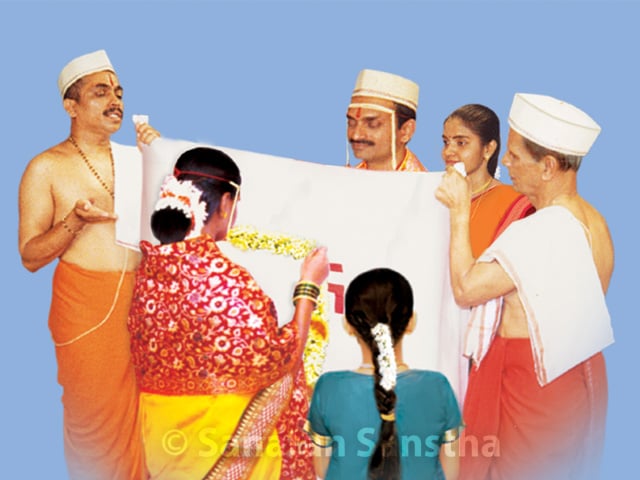
A clean double folded cloth held between the bride and the groom in south-north direction is called as ‘antahpat ’or ‘antarpat’. Two heaps of rice should be placed on the ground. On the rice kept in the east direction, the groom should be made to stand facing the west and on the rice on the west side, the bride should be made to stand facing the east. Then both should be given a mixture of some rice, jaggery and cumin seeds in their palms. Of the sanskars performed individually on the bride and the groom, this is the last ritual. Behind the bride and the groom, a female relative of theirs stands holding kara in hand. Kara is a copper pot containing water and a betel nut. A small branch of mango tree and a coconut is also kept on the copper pot.
B. Reciting mangalashtake (Eight auspicious verses)
When the Hindu marriage ritual of holding the antahpat is in progress, mangalashtake as mentioned in the scriptures are recited.
-
Importance : Through mangalashtake, different Deities are invoked and through the melodious recitation of mantras, they are attracted at the level of Chaitanya (Divine consciousness) towards the venue to bless the bride and the groom. This sound charges the eight directions and when Chaitanya from God advances towards the earth from the urdhva (Upward) direction, the two directions urdhva and adho (Downward) get charged with Chaitanya. In this way, the Chaitanya that is emitted through the mangalashtake and which is attracted to the sound charged with Tej (Absolute Fire Principle) in the form of mantrashakti, purifies the entire atmosphere and charges it.
-
Prevent malpractices taking place with regards to mangalashtake! : Instead of reciting mangalashtake written by modern poets that are devoid of Chaitanya, recite those as mentioned in the scriptures. Mangalashtake should be recited with bhav (Spiritual emotion) instead of reciting them in a high pitch to the tune of film songs. It is a common practice to give a thunderous applause after recitation of mangalashtake. Playing loud music after this is also undesirable since it can obstruct the Sattva waves coming towards the Hindu marriage venue. Only soft and melodious sound emanating from auspicious musical instruments attracts Sagun (Materialised) waves of Deities. Hence, as a symbol of auspiciousness, after completing mangalashtake musical instruments should be played very softly.
C. Parasparnirikshan vidhi and garlanding each other
![]()
After playing musical instruments, following mantra is recited and the antahpat is drawn open towards the north. Thereafter, the priest asks the couple to shower on each other’s foreheads a mixture of rice grains, jaggery and cumin seeds :
तदेव लग्नं सुदिनं तदेव ताराबलं चन्द्रबलं
तदेव । विद्याबलं दैवबलं तदेव लक्ष्मीपते तेऽङ्घ्रियुगं स्मरामि ।।
(Meaning : O Bhagwan Shrivishnu, husband of Devi Lakshmi, the remembrance of your Holy feet itself is marriage, the auspicious muhurt [time], strength of the stars, strength of the moon, strength of knowledge and strength of the Deities.)
(Nowadays, however, rice grains, jaggery and cumin seeds are not used). The couple is asked to look at each other lovingly and are told to garland each other. First the bride garlands the groom and then the groom garlands the bride.
Subtle-effects of the bride and the groom garlanding each other :
-
In the sanskar of Hindu marriage, the prime objective underlying the act of garlanding each other (the bride and the groom) is to experience the divinity in each other.
-
When the bride garlands the groom, she worships the Shiv Principle in him. At that time, the Shiv Principle in the groom in unmanifest form becomes active in the manifest form.
-
When the groom garlands the bride; he worships the Devi (Female Deity) Principle in her. At that time, the Devi (Shakti) Principle in the bride in unmanifest form becomes active in the manifest form.
-
Having a bhav that ‘there is divinity in both of us’ while garlanding, benefits both.
-
Ill-effects of lifting the bride and the groom when they garland each other : In some places, while exchanging garlands during the Hindu marriage ceremony, to tease the groom and make it difficult for him to garland the bride, the bride is lifted. At times, the groom too is lifted. This inappropriate action obstructs the vibrations of Deities attracted to the venue of the marriage. In fact, this action leads to emission of Tama vibrations into the environment. Taking advantage of this, negative energies in the atmosphere emit vibrations of black energy at the venue of the marriage. This can affect the groom and the bride.
D. Akshataropan vidhi
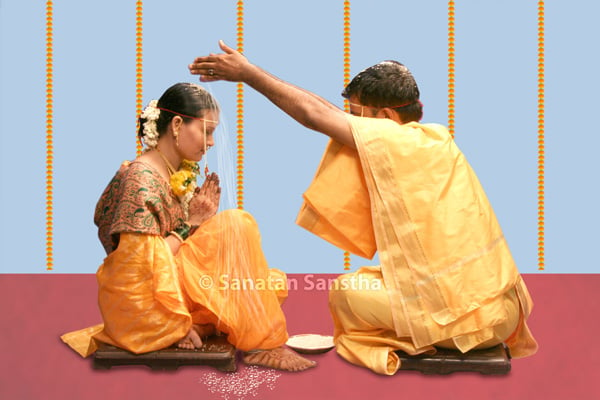
The appropriate method of showering akshata on the bridal couple is Akshataropan vidhi : Today, most of the times while reciting the mangalashtake when the line ‘shubamangal savadhan’ is uttered the people present at the venue throw akshata on the couple. In the ancient times, after the Hindu marriage ritual of ‘kankanbandhan’, the bride and groom would shower akshata on each other to fulfil their desires pertaining to Dharma (Righteousness), artha (Material gain), kama (Desire), progeny etc. Based on this, instead of throwing akshata on the bridal couple it would be more appropriate to shower them in the following manner. After the bride and groom garland each other, the couple should sit facing each other with the groom facing the east and the bride facing the west. Then, taking akshata in hand the bride should shower akshata on the head of the groom first followed by the groom doing the same to the bride. This should be done three to five times amidst recitation of ‘ऋक्चवा इदमग्रे०’ mantra by the priest. Then the bride and groom should sit together, the wife to the left of the husband, and the parents of both, guests in the Hindu marriage procession and other invitees should stand in a queue and shower akshata over the bride and the groom and conclude this ritual of Hindu marriage. The bride and the groom should then stand up and receive blessings from all those present.
Subtle effects of showering the bride and the groom with akshata :
-
Akshata have a high ability to attract Principles of Deities from the Universe. That is why; they are used in a puja (Ritualistic worship) or other religious rituals.
-
Akshata are a symbol of happiness, prosperity, wealth, food grain and progeny. Hence, the moment akshata touches the heads of the bride and the groom; it helps in making the marital and worldly life of the couple prosperous.
-
The moment akshata are showered by elders on the bride and the groom, Principles of Deities that are attracted towards the akshata enter the bodies of the bride and the groom and remain there for a long time. This benefits the couple at a spiritual level.
-
Loss upon akshata being thrown from a distance : Since the akshata do not fall on the heads of the couple, the couple does not benefit from the vibrations emitted by the akshata. Akshata charged with the Principle of Deities are trampled upon by guests in the Hindu marriage, thus dishonoring the Principle of Deities present in them.
E. Sutraveshtan
In order to show that ‘the bride and the groom have become one by heart’, the ritual of Sutraveshtan has been devised in the rituals of Hindu marriage. The thread is wound beginning from the north-east direction (the direction of God) and the number of rounds is five because the physical body is surrounded by five Cosmic Principles.
F. Kankanbandhan
Vermilion is applied to the tip of the thread used in the ritual of Sutraveshtan. It is twisted and a piece of turmeric and wool is tied to it. The groom should tie it to the bride’s left wrist. Then removing the thread from the waist, wool and a piece of turmeric are tied to it. The bride should tie it to the right wrist of the groom.
G. Mangalsutra bandhan (Tying the mangalsutra)

The word ‘mangal’ in mangalsutra means auspiciousness; while the word ‘sutra’ means bondage.
Implied meaning of mangalsutra : In Sanskrit, mangalsutra is also known as ‘mangalyatantu’. A mangalsutra has black beads woven in two strands of thread. The two strings of mangalsutra represent the bond between a husband and wife; four beads represent four Purusharthas – Dharma, artha, kama and Moksha (Final Liberation), and the two cups represent Shiv-Shakti. Karma is successful only if it is associated with both Shiv and Shakti (Divine Energy). The string that joins the two cups is indicative of the permission granted by Dharma to worship the Kuladevata (Family Deity) of the groom.
Significance of the mangalsutra :
-
Mangalsutra is an ornament which imbibes the Divine Principle to the maximum extent.
-
Soubhagyalankar like the mangalsutra make a woman aware of her chastity and also protect her from negative energies.
Kanthamani–mangalsutra : Kanthamani means the muhurtamani which is tied at the Vishuddha-chakra. This is a simple gold bead devoid of any design, present in the middle of the black beads woven in a cotton thread. Waves of Tej-tattva (Absolute Fire Principle) which are attracted to this gold bead from the Universe, keep the Vishuddha-chakra constantly in an activated state. The custom of removing this bead (which was tied around the neck of the bride on the day of marriage) after sixteen days is incorrect. The inseparable bond between the word kanthamani-mangalsutra has been preserved by Dharma itself.
Mangalsutra (with cups) : As far as possible, the length of the mangalsutra should be such that it reaches the Anahat-chakra. The cups in the mangalsutra should be round, without any design or carvings on its reverse side. For a new bride, do not make a mangalsutra with various designs or in a shell like pattern or with intersecting vertical and horizontal lines on the cups. One such example is given below
H. Vivah-hom
The ritual of Vivah-hom is performed to express acceptance of the bride as the wife and beginning a new life together.
I. Panigrahan (The nuptials)
Panigrahan is when the groom clasps in his hand the hand of the bride, with her fingers and her palm facing downwards.
J. Lajahom
Laja means parched corn. Flakes of corn (as well as rice) represent a swollen vagina and symbolise high fertility. First the groom should wash both the hands of the bride with clean water and asking her to make an anjali, he should put a little ghee (Clarified butter) with a wooden spoon (used in rituals) into the cupped palms and smear it onto her palms. Then the bride’s brother or his representative should twice put fistful of parched corn from a winnow into the bride’s cupped palms. By this act, the brother gives his consent to the marriage. The groom should pour some ghee over the corn in the winnow and the anjali. He should hold the bride’s anjali with both his hands and offer all the corn from it into the sacrificial fire. Then along with the bride, the groom should circumambulate the site of the sacrificial fire, the water pot and the fire, excluding the flat grinding stone and muller. When circumambulating, he should hold the bride’s hand and walk ahead of her. According to a popular custom, the bride’s brother twists the groom’s ear at this juncture.
K. Saptapadi (Seven steps)
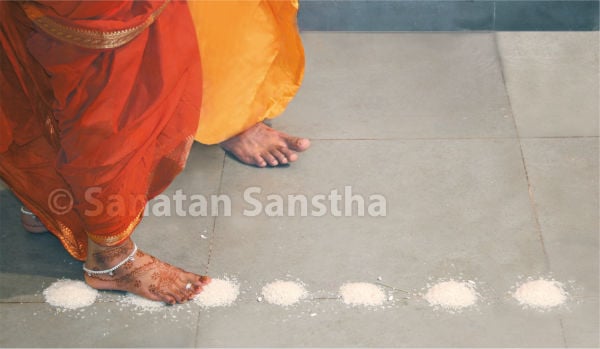
The meaning of this Hindu marriage ritual is – ‘The bride and groom should discard all sanskars of the past seven births and start a conjugal life that is complementary to each other’. It is said in scriptures that ‘by walking seven steps together, friendship develops’. Hence, the importance of Saptapadi in the Hindu marriage sanskar. The act of the groom holding the hand of the bride and walking seven steps towards the north of the hom over the seven heaps of rice is termed as saptapadi. As the bride and groom take every step, the priest recites a mantra. The saptapadi are steps taken to be liberated from the Saptaloks (Seven higher regions) and saptakoshas (Seven subtle sheaths) as a couple. A Hindu marriage gets legalized only after completion of the saptapadi.
Subtle-benefits obtained when the bride and groom walk together in a saptapadi :
-
When a bride walks seven steps holding the hand of the bridegroom, negative sanskars of each of her past births get reduced to some extent when her big toe touches each mound of rice. (However, she should have such a bhav at this time.)
-
The moment bride’s right big toe touches the mound of rice, Shakti is attracted into it. Shakti Principle is inactive in other mounds of rice that have not come in contact with the bride’s foot yet.
-
Saptapadi makes a bride remain constantly with her husband, thus by behaving according to his wish (parecchha for her) she attains dissolution of mind and intellect.
-
The vows taken while touching the mounds of rice grains at every step affects the subconscious mind of the bride and helps in consolidating the sanskar of saptapadi on it.
-
Due to the sattvikta (Purity) in Sanskrut shlokas, the woman obtains Karyashakti (Energy of action) which makes her worldly life fruitful. Therefore, her married life becomes blissful.
L. Offering aher (Gifts) to the bride and groom
Today offering huge, expensive gifts is considered as aher. However, in reality it is a karma performed out of emotion. ‘Aher’ actually means something which cannot be snatched.
-
What should be given as aher? : Considering the individual who is accepting the aher (on whom the sanskar is being performed) to be a form of God, gift something which will be conducive for his spiritual progress. A few examples of ideal aher are – Holy texts that teach about sadhana (Spiritual practice) for God-realisation, sattvik (Sattva-predominant) pictures of Deities which evoke devotion and bhav, sattvik Name-strips of Deities etc.
-
What bhav should we have while offering or accepting aher? : Nowadays, aher is offered amidst much fanfare, which is inappropriate. An aher should be offered without any ego and without any expectations from the recipient, else it generates a give-and-take account between the individuals. The bride and the groom receiving aher should do so with a bhav that they are receiving ‘Prasad (Holy sacrament) from God in the form of an object or wealth’.
Reference : Sanatan Sanstha’s Holy text ‘Marriage sanskar’

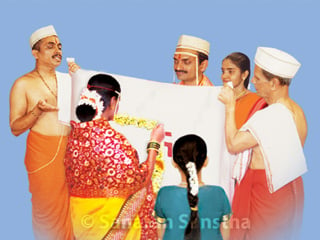 Spiritualize every act performed in a Hindu Marriage ceremony !
Spiritualize every act performed in a Hindu Marriage ceremony !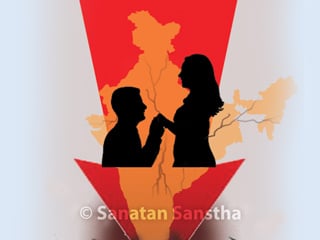 Danger of collapse of the family system due to the resulting immorality !
Danger of collapse of the family system due to the resulting immorality !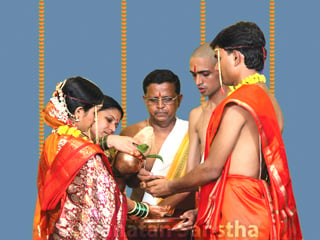 Kanyadan
Kanyadan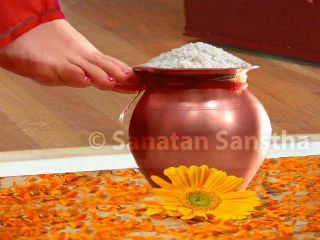 Vadhu Griha-pravesh and other rituals which are performed after the Marriage
Vadhu Griha-pravesh and other rituals which are performed after the Marriage